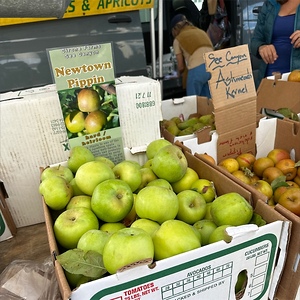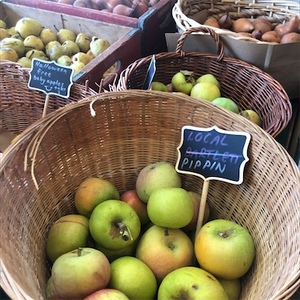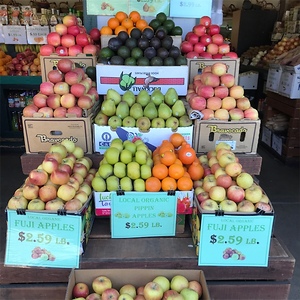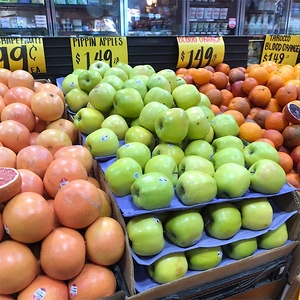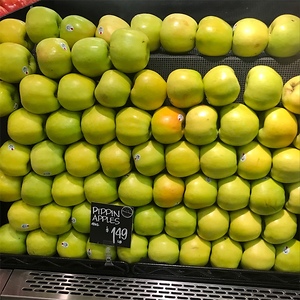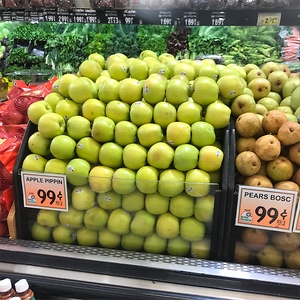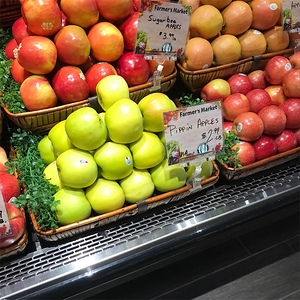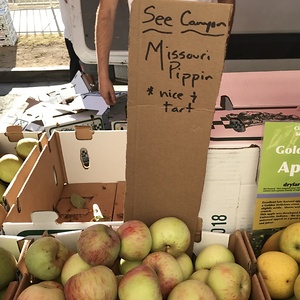


Pippin Apples
Estimated Inventory, 88 ct : 0
Description/Taste
Pippin apples vary in size, shape, and appearance, ranging from small to large and round, ovate, to conical in shape. There are several apple varieties labeled as Pippins, and some of the fruits are uniform, while others may have a slightly lopsided or irregular appearance. The apple's skin can be thin to thick and generally has a taut nature. The skin may also be ribbed, waxy, matte, glossy, or covered in patches of brown russet and showcases variegated shades of golden yellow or green with dark red, light red, and orange blush. Pippin apples also exhibit pale lenticels on the surface, giving the skin a faintly speckled look. Underneath the skin, the flesh is white, pale green, to ivory with an aqueous, soft to firm, and fine-grained to a coarse consistency. The flesh also bears a crisp, crunchy, and succulent texture and encases a central fibrous core filled with tiny black-brown seeds. Depending on the variety, Pippin apples are aromatic when ripe and vary in flavor from sweet, sweet-tart, to sharp and acidic. The apples may also have a refreshing to sprightly taste combined with spice-filled, fruity, or floral nuances and are consumed fresh or utilized in cooked preparations. Some varieties require a period of storage after harvest to develop a sweeter taste. Other Pippin apples can be consumed directly from the tree.
Seasons/Availability
Pippin apples vary in availability, depending on the variety. Most cultivars are harvested in the late fall through early winter and can be stored until the spring. A few Pippin varieties may ripen in mid-summer.
Current Facts
Pippin apples, botanically classified as Malus domestica, are a category of apple varieties belonging to the Rosaceae family. Historically, Pippin was an old English word derived from the French word "Pepin," meaning "seedling" or the "pip of a fruit." Pippin apples were traditionally developed from seed, and several well-known Pippin varieties are cultivated worldwide, especially in England, France, and the United States. Over time, the term Pippin has been loosely used for many apple cultivars, including Allington Pippin, Cox's Orange Pippin, King of the Pippins, Ribston Pippin, Stumer Pippin, St. Edmund's Pippin, Green Pippin, Bridgewater Pippin, Missouri Pippin, Bullock Pippin, Abram's Pippin, Wyken Pippin, Allington Pippin, Hauer Pippin, and July Pippin. In the United States, Newton Pippin apples are the most well-known of the Pippin varieties, and the heirloom apple is also one of the oldest commercially grown cultivars in the country. Pippin apples are favored for their versatile nature and are utilized in beverages, desserts, and sauces.
Nutritional Value
Pippin apples, depending on the variety, are a source of fiber to regulate the digestive tract, potassium to balance fluid levels within the body, and vitamin A to maintain healthy organs. The apples also provide vitamin C to strengthen the immune system, vitamin K to assist in faster wound healing, vitamin E to protect the cells against the damage caused by free radicals, and other nutrients, including calcium, copper, manganese, magnesium, and B vitamins. Some Pippin varieties may exhibit red blush on the skin. This red pigmentation indicates the presence of anthocyanins, compounds with antioxidant properties to reduce inflammation within the body.
Applications
Pippin apples vary in taste from sweet to sweet-tart and are suited for fresh and cooked preparations. The apples can be consumed straight, out of hand, or they are placed in storage for 1 to 2 months to increase sugar content, reduce acidity, and develop a pleasing, complex flavor before they are eaten. This preference is largely dependent on the type of Pippin apple. Once the apples are determined fit for eating, the fruits can be sliced and served on cheese boards, chopped into salads, shredded into slaws, or layered as a crunchy addition to sandwiches. Notably, the flesh of select Pippin varieties browns quickly, so the apples should be used shortly after slicing. Pippin apples can also be simmered into jams, jellies, chutney, and preserves, infused into syrups, or cooked into sauces. Try incorporating Pippin apples into muffins, bread, cake, or cookies or using the fruits to make waffles, fritters, dumplings, crisps, and cobblers. The apples can also be dried for extended use or ground into small pieces for use in spices and various seasonings. In addition to culinary preparations, Pippin apples are popularly added to ciders, juices, smoothies, and cocktails as a flavor enhancement. Some varieties of Pippin apples are also used in the blend for Martinelli's Sparkling Cider, created by a famous beverage company based in Watsonville, California. Pippin apples pair well with spices such as cinnamon, clove, and nutmeg, honey, vanilla, caramel, fruits including oranges, apricots, and grapes, dates, nuts such as almonds, pecans, and walnuts, and gorgonzola cheese. Whole, unwashed Pippin apples will keep for 1 to 4 months when stored whole and unwashed in a cool, dry, and dark place such as the refrigerator.
Ethnic/Cultural Info
Albemarle Pippin apples were a favorite variety of Queen Victoria in the 19th century. The American-born apple was thought to be the same variety as Newton Pippin apples but was renamed after a county in Virginia where it became a popular home garden cultivar. Many residents of Albemarle County believed their apples developed a unique flavor from Virginia's soil and climate, distinguishing the fruits from other Newton Pippin apples grown across the country. In the 19th century, American minister to Great Britain, Andrew Stevenson, gave Queen Victoria of England a basket of apples as a gift. The gift basket was received with such high favor that the Queen lifted the tariff on the imported variety to allow the fruits to be exported into England. Albemarle Pippin apples quickly became a coveted specialty cultivar in England, and wealthy English households paid triple the price of local varieties to sample the American variety. The cultivar remained a staple apple in English markets until World War I when levied duties were reinstated on non-Commonwealth fruits.
Geography/History
The term Pippin apple is a general descriptor used for several apple varieties grown from seed. Pippin was first used in the English language sometime during the 15th century and is derived from French. After its initial use as an apple descriptor, several European growers began using the term Pippin to describe many types of apples. Pippin was extensively used in England and France, and notable Pippin varieties included Cox's Orange Pippin, St. Edmund's Pippin, Ribston, and Wyken Pippin. Pippin apples were also being grown in the United States and were planted in commercial and home gardens. One American variety, Albemarle Pippin apples, was one of Thomas Jefferson's favorite varieties. It was reported that over fifty Albemarle Pippin apple trees were planted in his Monticello gardens sometime between 1769 and 1814. Today Pippin apples are grown worldwide and are mainly found in Europe, Canada, Australia, and the United States, typically sold through fresh markets, direct from growers, or select distributors.
Recipe Ideas
Recipes that include Pippin Apples. One



